Google AI Overviews have fundamentally transformed how users interact with search results—and the data is startling. According to recent studies from Pew Research Center, only 8% of users click on traditional search results when a Google AI Overview appears on the page, compared to 16% when no AI summary is present. That’s a 50% reduction in click-through rates.
But here’s where it gets interesting: Google’s VP of Search, Liz Reid, recently revealed exactly what type of content does get clicked when Google AI Overviews appear—and it’s not what most marketers expect. While overall traffic may be declining, the content that earns clicks is actually getting more engaged visitors who spend more time on site and bounce less frequently.
In this comprehensive guide, we’ll break down Google’s official statements about what content performs well in Google AI Overviews, analyze the latest data on click behavior, and provide actionable strategies to help your content succeed in this new search landscape.
Table of Contents
The Current State of AI Overviews in 2025
Before diving into what gets clicked, let’s understand the scale of AI Overviews’ impact on search.
Google AI Overviews Are Rapidly Expanding
According to Semrush’s analysis of 10 million+ keywords:
- 13.14% of all queries triggered AI Overviews in March 2025
- That’s up from 6.49% in January 2025 (a 72% increase in just two months)
- Some reports suggest AI Overviews now appear in over 50% of searches
Advanced Web Ranking data shows AI Overviews have doubled since August 2024, marking a major inflection point in search evolution. What started as an experimental feature is now reshaping the entire search experience.
The Traffic Impact Is Significant
Multiple independent studies confirm substantial traffic reductions:
Ahrefs Research (300,000 keywords analyzed):
- Average CTR for #1 ranking: 7.3% in March 2024 (before AI Overviews)
- Average CTR for #1 ranking: 2.6% in March 2025 (after AI Overviews)
- Result: 34.5% decrease in organic clicks
BrightEdge Data (One-Year Analysis):
- Search impressions: Up 49% year-over-year
- Click-through rates: Down 30%
- Zero-click searches: Increased from 56% to 69%
Pew Research Center (68,879 searches analyzed):
- 18% of all Google searches produced an AI summary
- Only 8% of users clicked through when Google AI Overview appeared
- 26% closed without clicking any links (vs 16% for standard results)
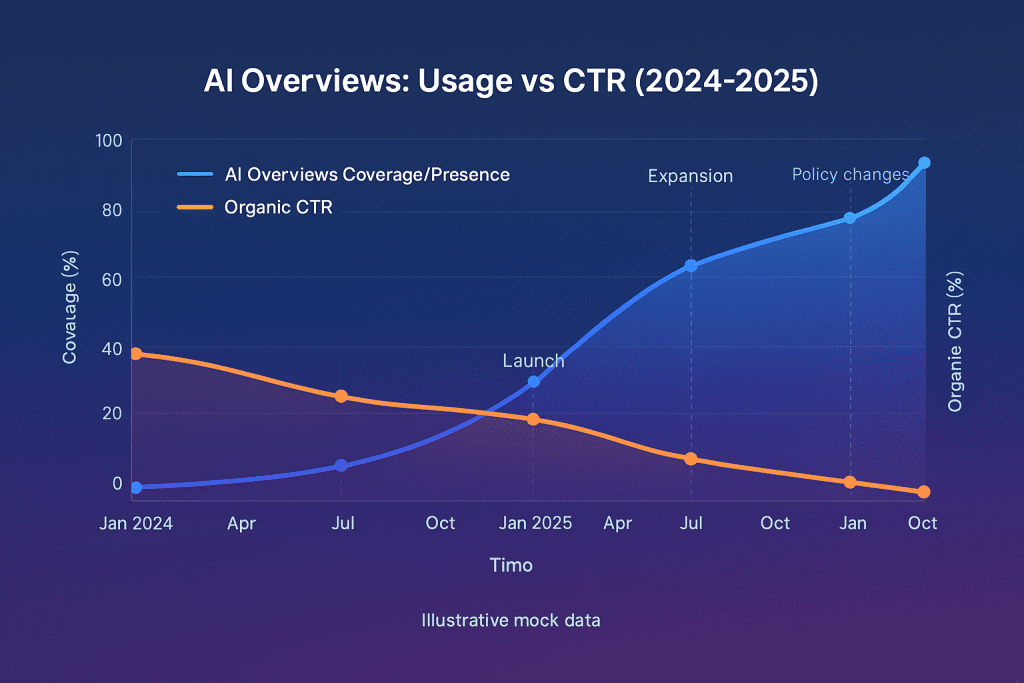
What Google Says Gets Clicked: Liz Reid’s Insights
In a recent interview, Google’s VP of Search, Liz Reid, provided rare insights into what content actually earns clicks in Google AI Overviews. Her comments reveal a crucial shift in how Google is evaluating content quality.
Rich and Deep Content Wins
“What we see is people want content from that human perspective,” Reid explained. “They want that sense of like, what’s the unique thing you bring to it, okay? And actually what we see on what people click on, on Google AI Overviews, is content that is richer and deeper.”
Reid emphasized that surface-level, AI-generated content doesn’t perform well: “That surface-level AI generated content, people don’t want that because if they click on that, they don’t actually learn that much more than they previously got.”
The Anti-Echo Chamber Strategy
Perhaps most importantly, Reid revealed that Google is actively down-ranking content that simply echoes what’s already widely said: “The unique thing you bring to it” is what matters. This represents a fundamental shift away from the traditional “skyscraper content” strategy where marketers would simply create longer, more comprehensive versions of existing content.
Lower Bounce Rates for Quality Content
Reid noted that Google AI Overviews help surface better content, resulting in “fewer what we call bounce clicks.” When users do click through from Google AI Overviews, they’re finding more valuable content that keeps them engaged rather than sending them back to the search results.
Google’s Expanded Definition of Spam
Reid also revealed that Google has extended its concept of spam to include “content that does not bring the creator’s perspective and depth.” This means thin, generic content isn’t just performing poorly—it may actually be classified as spam by Google’s systems.
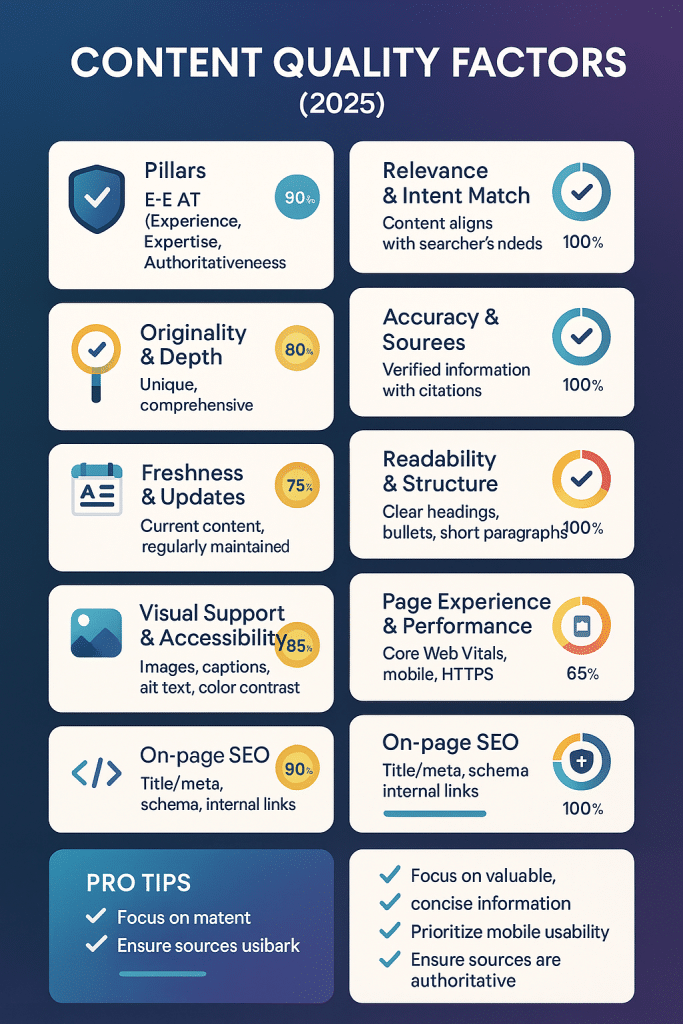
The Quality vs Quantity Paradox
Here’s the paradox that’s confusing many marketers: while overall click volume is declining, the traffic that does come from Google AI Overviews is actually higher quality.
Higher Engagement Metrics
Multiple studies confirm that users who click through from Google AI Overviews show superior engagement:
Adobe Analytics 2025 Report:
- 23% lower bounce rates compared to traditional organic traffic
- 41% more time on site
- 12% more pages per visit
- Higher conversion intent
TrustRadius Research:
- 90% of B2B buyers click through to cited sources to validate information
- AI summaries act as quality filters, pre-qualifying visitors
Why AI-Driven Traffic Converts Better
John Mueller from Google explains that Google AI Overview visitors tend to show “higher-quality engagement” because:
- The AI summary primes users with context before they arrive
- They’re not clicking in blind they know what to expect
- They’re specifically seeking deeper information beyond the summary
- Lower exit rates indicate content meets their needs
This means fewer visitors, but more qualified ones. For businesses focused on conversions rather than pure traffic numbers, this could actually be beneficial.
Which Industries Are Most Affected?
Google AI Overviews don’t impact all sectors equally. Here’s how different verticals are experiencing the shift:
Heavily Impacted Industries
Healthcare & Education
- Approaching 90% query coverage with AI Overviews
- Informational queries completely dominated
- Patient education sites seeing significant traffic drops
B2B Technology
- Coverage grew from 36% to 70% in one year
- “How-to” and comparison queries fully covered
- SaaS companies must rethink content strategy
Insurance
- Coverage jumped from 17% to 63%
- Quote comparison queries now answered directly
- Lead generation heavily impacted
Entertainment
- Grew from 2% to 37% coverage
- Review and recommendation queries affected
- Affiliate sites seeing reduced clicks
Less Impacted Industries
E-Commerce
- Google AI Overview presence actually declined from 29% to 4%
- Transactional queries still drive traditional results
- Product pages relatively protected
Local Services
- Limited Google AI Overview presence
- Location-specific queries favor traditional results
- Local dealerships see CTR increase when included
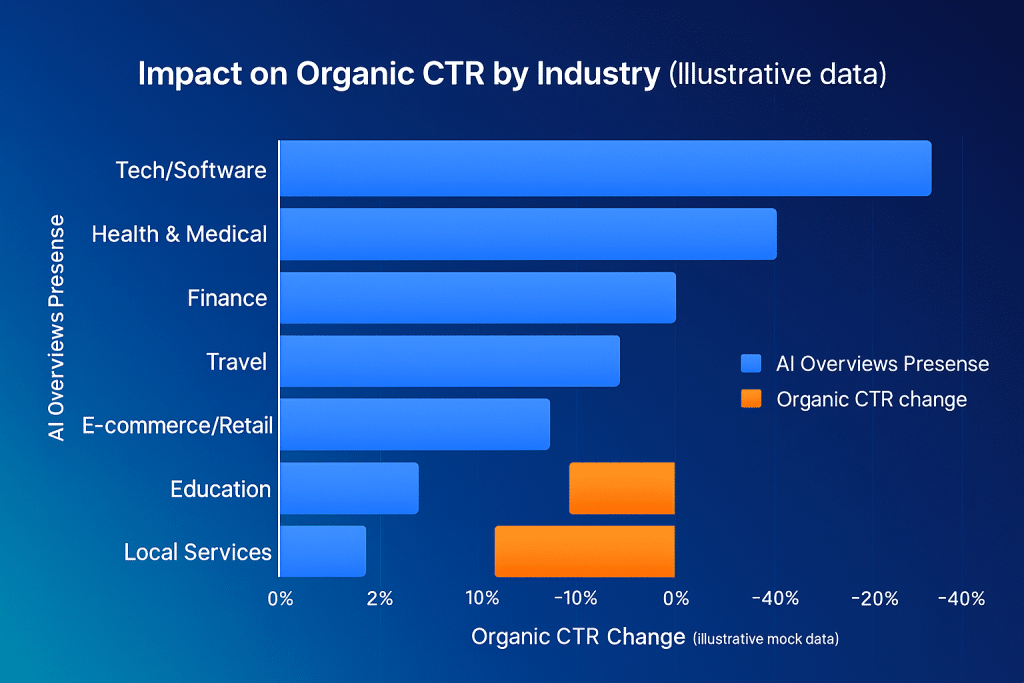
What Type of Queries Trigger Google AI Overviews?
Understanding which searches generate Google AI Overviews helps you determine where to focus your content strategy.
Query Length Matters
Pew Research findings:
- 8% of 1-2 word searches produce Google AI Overviews
- 53% of searches with 10+ words produce Google AI Overviews
Longer, more conversational queries are far more likely to trigger AI summaries. This aligns with how people naturally ask questions when seeking detailed information.
Intent Type Breakdown
Semrush analysis of 10M+ keywords:
- Informational queries: 88.1% trigger Google AI Overviews
- Navigational queries: 1.43% (doubled since January)
- Commercial/transactional: Only 10% likelihood
“How,” “what,” “why,” and “compare” queries are the most affected, while branded and buying-intent searches remain relatively safe.
Emerging Query Patterns
Three key shifts in search behavior:
- Longer, multi-part questions – Users ask complete questions expecting comprehensive answers
- Multimodal inputs – Image + text queries (“Why is this leaf turning brown?”) rising quickly
- Expectation of immediate answers – Users want quick facts without clicking
Strategies to Succeed With Google AI Overviews
Based on Google’s guidance and industry data, here are proven strategies to maintain visibility and clicks:
1. Create Uniquely Deep Content
What to do:
- Focus on niche depth over broad coverage
- Share proprietary data, original research, and surveys
- Include firsthand experiences and case studies
- Provide analysis that goes beyond what AI can synthesize
Example: Instead of “10 Best Project Management Tools,” create “How We Reduced Sprint Planning Time by 40% with [Specific Tool]: A 6-Month Analysis”
2. Embrace Structured Formats
Content types that perform well:
- FAQ sections – Direct Q&A format
- Step-by-step guides – Numbered processes
- Comparison tables – Side-by-side analysis
- Lists with depth – Each point thoroughly explained
- Video content – Visual explanations (seeing largest increase in Google AI Overview mentions)
3. Leverage Structured Data
Implement schema markup to help Google understand your content:
- FAQ schema
- HowTo schema
- Review schema
- Product schema
- Article schema
4. Target Mid-to-Bottom Funnel Keywords
Why this matters: Non-branded, top-of-funnel keywords are hit hardest by Google AI Overviews. Shift focus to:
- High-intent searches closer to conversion
- Specific problem-solving queries
- Comparison and evaluation terms
- Product-specific information
Example shift:
- FROM: “What is CRM software?” (heavily covered by AI)
- TO: “Best CRM for real estate teams under 10 people” (specific, conversion-focused)
5. Build Authority Signals
Content from high-authority sites appears more frequently in Google AI Overviews. Focus on:
- Earning quality backlinks
- Getting cited by reputable sources
- Building brand mentions
- Creating shareable original research
- Guest posting on authoritative sites
6. Optimize for Featured Snippets
Despite Google AI Overviews, Featured Snippets remain highly clickable.
Optimization tactics:
- Use clear question-answer format
- Keep answers concise (40-60 words for definition boxes)
- Use bullet points and numbered lists
- Include the question in your H2/H3 headers
- Answer the question in the first paragraph
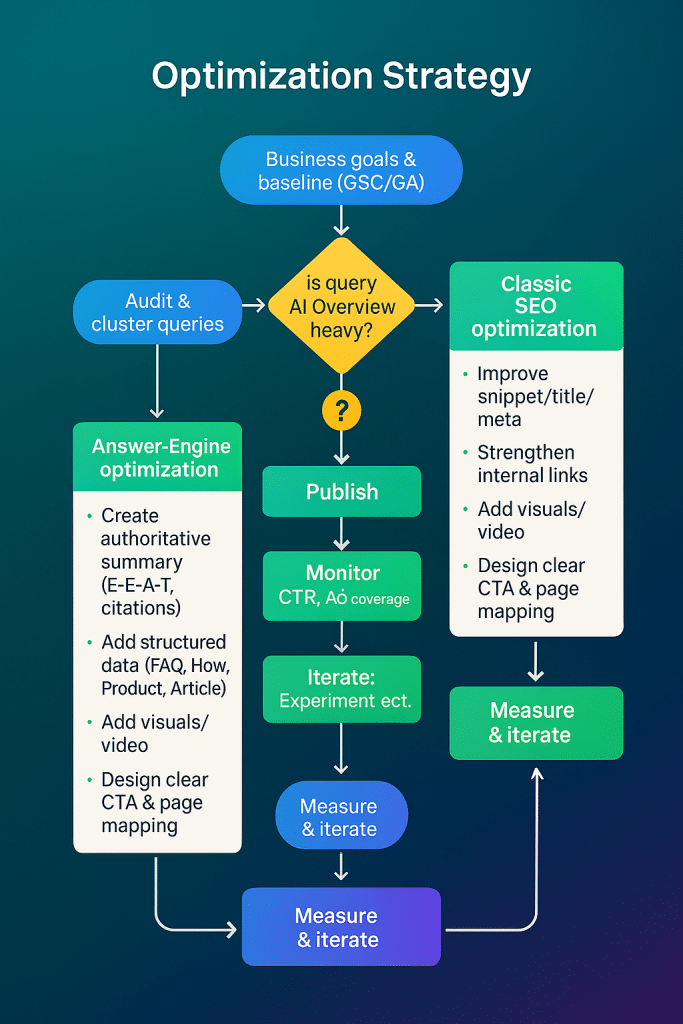
Measuring Success in the Google AI Overview Era
New KPIs to Monitor
Beyond simple traffic:
- Engagement metrics – Time on site, pages per session, scroll depth
- Conversion rates – Focus on quality over quantity
- Brand lift indicators – Direct traffic, branded search growth
- Assisted conversions – Track full customer journey
- Google AI Overview visibility – Monitor citations in summaries
The “Higher Quality Click” Hypothesis
Google claims clicks from Google AI Overviews are “higher quality.” Validate this by comparing:
- Bounce rates for AIO traffic vs traditional organic
- Average session duration
- Conversion rates by traffic source
- Revenue per visitor
The Future of Search and Google AI Overviews
AI Mode and Beyond
In May 2025, Google introduced AI Mode—a more conversational interface that further reduces traditional link visibility. This suggests Google is doubling down on AI-first search experiences.
Ad Integration Coming
Google has begun testing ads within Google AI Overviews. Elizabeth Reid stated: “We see a lot of opportunities for ads—above, below and within the overview.” Expect:
- Shopping carousels nested in AI summaries
- Paid placements in citation lists
- New ad formats designed for AI context
Multi-Platform Strategy Required
Search is no longer synonymous with just “Googling.” Consider:
- ChatGPT Search – Growing as alternative search engine
- Perplexity – AI-native search gaining traction
- Social platforms – TikTok, Reddit as discovery channels
- Voice assistants – Alexa, Siri using different algorithms
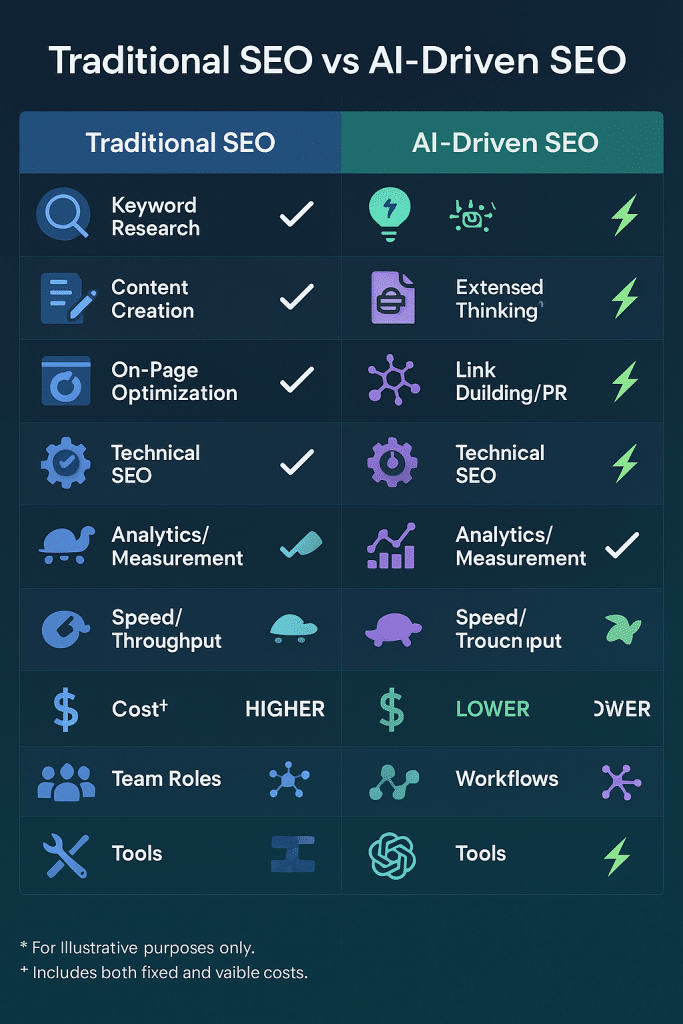
Conclusion
Google AI Overviews represent the most significant shift in search behavior since the introduction of Featured Snippets and perhaps since Google itself launched. While the data clearly shows traffic is declining for many sites (with CTR drops of 30-40% being common), this isn’t necessarily the death of organic search.
Google’s VP of Search, Liz Reid, has given us a clear roadmap: create content that is richer and deeper than what AI can synthesize, bring unique perspectives derived from real experience, and avoid the trap of simply echoing what’s already widely said. The content that succeeds will be authoritative, original, and structured in ways that both AI and humans can easily parse.
Yes, you’ll likely see less traffic overall. But the traffic you do get will be more engaged, spend more time on your site, and convert at higher rates. For businesses focused on actual outcomes rather than vanity metrics, this shift may ultimately be beneficial.
The key is to stop optimizing for rankings alone and start optimizing for AI visibility and user engagement. Use structured data, create genuinely valuable content, build authority in your niche, and focus on mid-to-bottom funnel keywords where intent is clear.
The search landscape is evolving rapidly, and Google AI Overviews are just the beginning. Those who adapt their strategies now focusing on quality, uniqueness, and genuine value—will be best positioned to succeed in the AI-powered search era.
Frequently Asked Questions (FAQ)
1. How can I tell if AI Overviews are affecting my website’s traffic?
Check Google Search Console for keywords where impressions are rising but clicks are falling or stagnant. This indicates users are getting answers from AI Overviews without clicking through. Compare your current CTR to historical data—drops of 30-40% for informational keywords suggest AI Overview impact. You can also use SEO tools like Semrush or Ahrefs to identify which of your ranking keywords trigger AI Overviews.
2. Does ranking #1 still matter with AI Overviews?
Yes, but differently than before. Position #1 still gets the most clicks among traditional organic results, but overall click volume is significantly reduced. Data shows the #1 position’s CTR dropped from 7.3% to 2.6% when AI Overviews appear. However, AI Overviews often cite sources from various ranking positions (nearly half cite pages ranking below position 10), so authority and content quality matter as much as pure ranking.
3. Should I stop creating informational content?
No, but you need to adjust your strategy. Informational content is still valuable—you just need to make it more unique and valuable than what AI can synthesize. Focus on adding original research, personal insights, case studies, and depth that goes beyond surface-level information. Google’s Liz Reid specifically said users click on content that’s “richer and deeper” than the AI summary.
4. How can I get my content cited in AI Overviews?
To increase your chances of appearing in AI Overviews: (1) Create authoritative, well-researched content with unique insights, (2) Use structured data markup (FAQ, HowTo, Article schema), (3) Format content with clear headings, lists, and tables, (4) Answer specific questions directly and concisely, (5) Build topical authority in your niche, and (6) Earn backlinks from reputable sources. Nearly 90% of AI Overviews cite three or more sources, so quality and relevance matter more than ranking position alone.
5. Are clicks from AI Overviews really “higher quality” as Google claims?
Yes, data supports Google’s claim. Multiple studies show that traffic from AI Overviews has 23% lower bounce rates, 41% longer time on site, and higher conversion intent compared to traditional organic traffic. This is because AI summaries act as a filter—users who click through are specifically seeking deeper information beyond what the summary provided. They arrive with context and are more qualified visitors, even though there are fewer of them.
6. Which content types perform best in the AI Overview era?
Content with structured formats performs best: FAQ pages, step-by-step guides, comparison tables, listicles with detailed explanations, and video content (which is seeing the largest increase in AI Overview mentions). Content that demonstrates expertise through original data, case studies, and unique perspectives also performs well. Avoid thin, generic content that simply echoes what others have said—Google’s Liz Reid confirmed this type of content is being down-weighted.
7. How is this affecting paid search (Google Ads)?
Paid search is also being impacted. Early data shows CTR for paid ads nearly halves in AI Overview-heavy SERPs, and WordStream reports CPCs increasing 12.88% year-over-year. Google is testing ad placements within AI Overviews, which may create new opportunities but likely at higher costs. Advertisers should focus on high-intent, bottom-funnel keywords where commercial intent is clear, as AI Overviews appear in only 10% of commercial/transactional queries.
8. What should I do if my website traffic is declining due to AI Overviews?
Take these steps: (1) Diversify your traffic sources—don’t rely solely on Google organic, (2) Focus on building direct relationships with your audience through email lists and social media, (3) Shift content strategy toward unique, authoritative content that can’t be easily summarized, (4) Target mid-to-bottom funnel keywords with clearer commercial intent, (5) Optimize for conversions rather than pure traffic, since remaining traffic is higher quality, and (6) Consider multi-platform distribution including ChatGPT, Perplexity, and social search.
Ready to optimize your content for AI Overviews? Start by auditing your existing content to identify opportunities for adding unique insights, implementing structured data, and improving content depth. The future of search rewards quality over quantity.
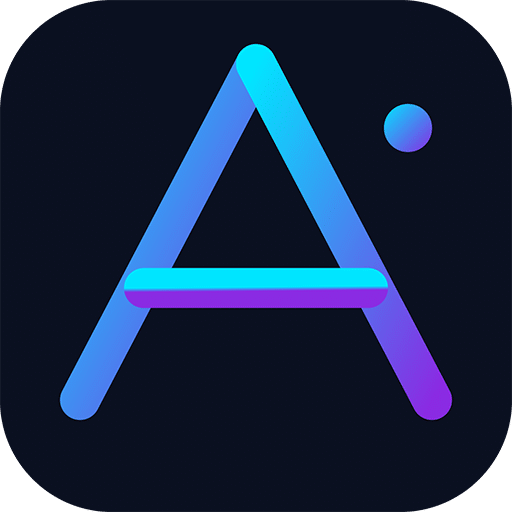
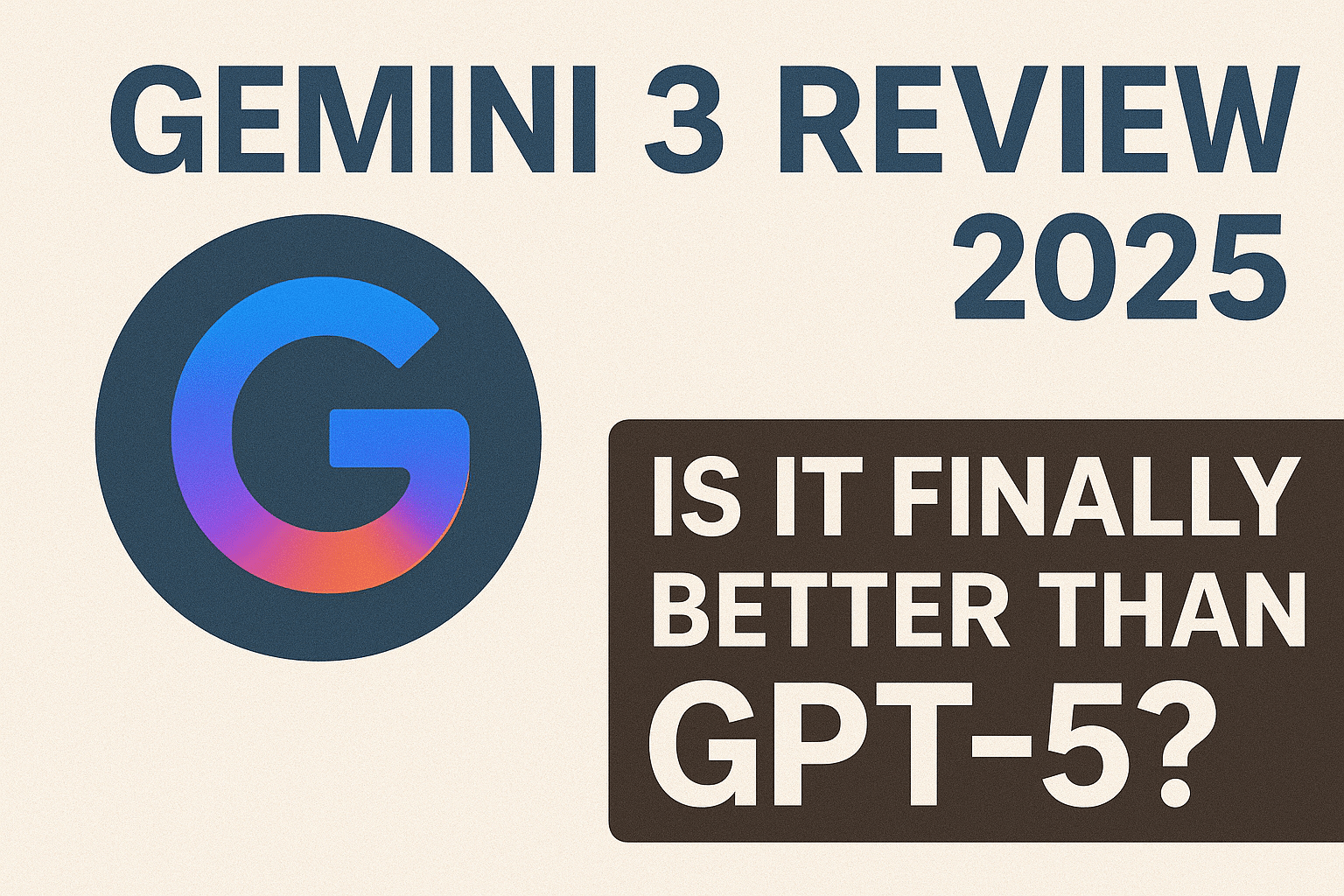
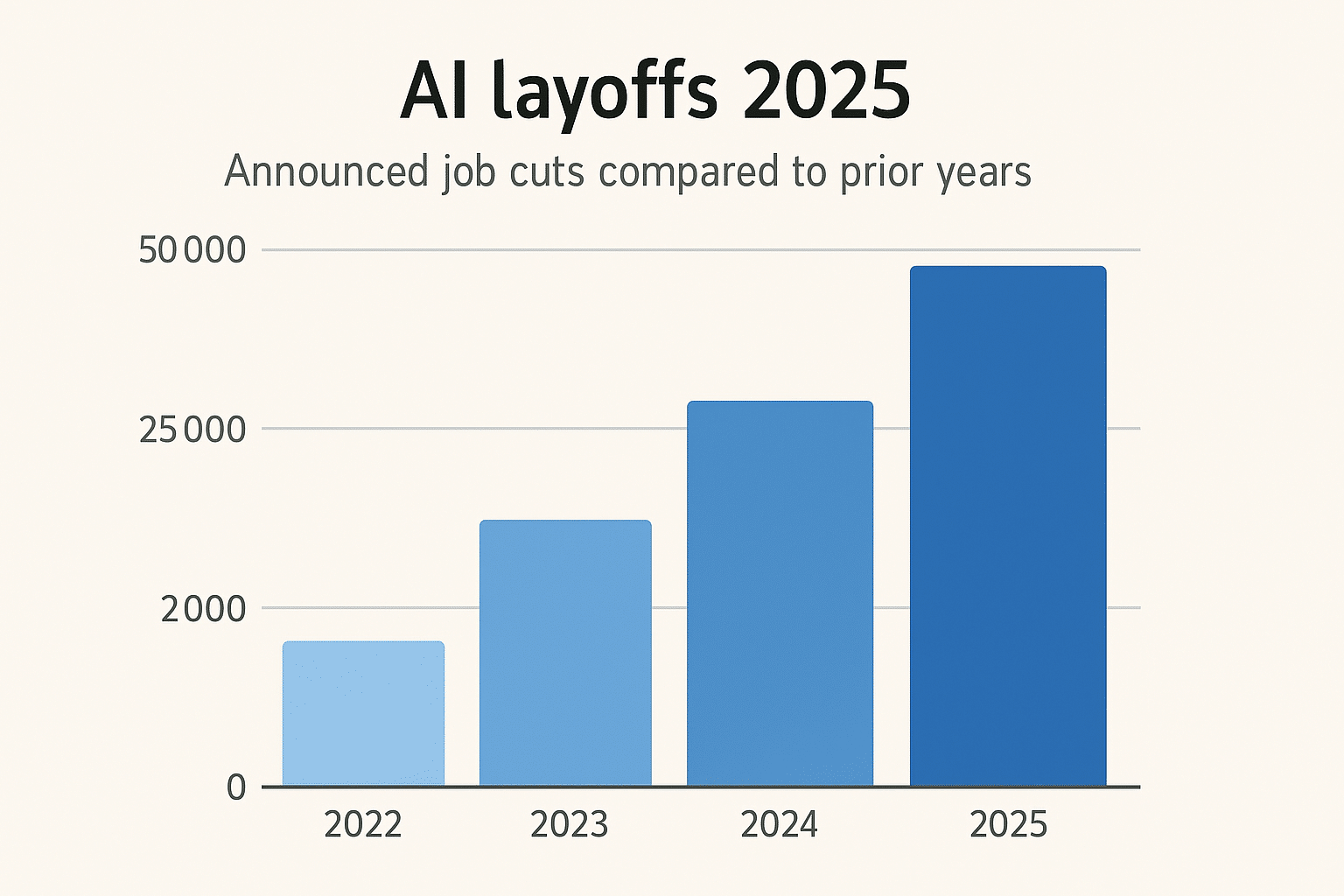






Leave a Reply